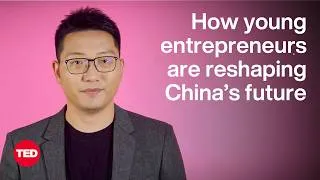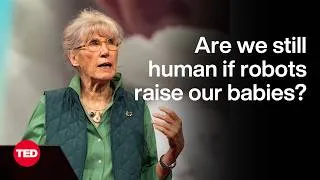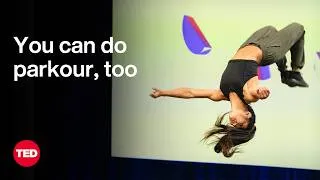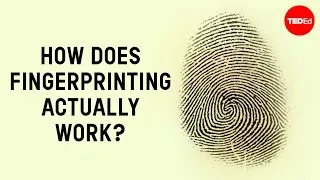请双击下面的英文字幕来播放视频。
翻译人员: Elvis Liu
校对人员: Tom Liu
00:06
Many of the inanimate objects around you
probably seem perfectly still.
0
6842
4826
你周围许多物体看似是完全静止的,
00:11
But look deep into the atomic structure
of any of them,
1
11668
3995
但请从微观原子结构上观察它们,
00:15
and you'll see a world in constant flux.
2
15663
2670
你会发现一个永不停息运动着的世界。
00:18
Stretching,
3
18333
805
扩张着,
00:19
contracting,
4
19138
929
压缩着,
00:20
springing,
5
20067
935
弹动着,
00:21
jittering,
6
21002
975
00:21
drifting atoms everywhere.
7
21977
3181
抖动着,
原子动来动去。
00:25
And though that movement may seem chaotic,
it's not random.
8
25158
3197
即使这种运动看似混乱,
它们其实有规律可循。
00:28
Atoms that are bonded together,
9
28355
1535
原子连接在一起,
00:29
and that describes almost all substances,
10
29890
2379
几乎构成了所有物质,
00:32
move according to a set of principles.
11
32269
2612
按照一定规律在运动着。
00:34
For example, take molecules,
atoms held together by covalent bonds.
12
34881
4895
例如分子中原子有着共价的联系。
00:39
There are three basic ways
molecules can move:
13
39776
2546
分子以三种基本规律运动:
00:42
rotation,
14
42322
892
旋转,
00:43
translation,
15
43214
1123
平移,
00:44
and vibration.
16
44337
1549
和振动,
00:45
Rotation and translation
move a molecule in space
17
45886
3152
旋转和转化时分子在空间中运动,
00:49
while its atoms stay
the same distance apart.
18
49038
3128
此时原子的间隙不变。
00:52
Vibration, on the other hand,
changes those distances,
19
52166
3442
然而振动会改变原子间距,
00:55
actually altering the molecule's shape.
20
55608
2642
实际上这改变了分子的形状。
00:58
For any molecule, you can count up
the number of different ways it can move.
21
58250
4438
每种分子都有一定数量的运动方式。
01:02
That corresponds to
its degrees of freedom,
22
62688
2616
运动方式的多少与其自由度有关,
01:05
which in the context of mechanics
23
65304
1637
用机械术语讲,
01:06
basically means the number of variables
we need to take into account
24
66941
3509
就是我们为了全面了解一个整体
01:10
to understand the full system.
25
70450
2895
而需要考虑的变量的数量。
01:13
Three-dimensional space is defined by
x, y, and z axes.
26
73345
4674
立体空间可用x,y,z轴描述。
01:18
Translation allows the molecule to move
in the direction of any of them.
27
78019
5015
平移可让分子朝各个方向运动。
01:23
That's three degrees of freedom.
28
83034
2064
这种运动方式在三个维度上都完全自由。
01:25
It can also rotate around
any of these three axes.
29
85098
3660
分子也可以围绕这三个坐标轴旋转,
01:28
That's three more,
30
88758
1232
这是另外三种运动方式,
01:29
unless it's a linear molecule,
like carbon dioxide.
31
89990
3052
除非它是像二氧化碳一样的线型分子,
01:33
There, one of the rotations just spins
the molecule around its own axis,
32
93042
4415
线型分子的一种旋转方式是绕自己
的轴线旋转,
01:37
which doesn't count because it doesn't
change the position of the atoms.
33
97457
4150
由于它的原子位置不变
这种方式不纳入旋转方式的种类。
01:41
Vibration is where it gets a bit tricky.
34
101607
2989
振动就有一些复杂了。
01:44
Let's take a simple molecule,
like hydrogen.
35
104596
2383
以氢分子为例
01:46
The length of the bond that holds the two
atoms together is constantly changing
36
106979
4703
它们的两原子间的间隙在不断变化,
01:51
as if the atoms were connected
by a spring.
37
111682
2797
就像被弹簧连接一样。
01:54
That change in distance is tiny,
less than a billionth of a meter.
38
114479
4506
这种间隙的改变很微小
小于十亿分之一米。
01:58
The more atoms and bonds a molecule has,
the more vibrational modes.
39
118985
4806
分子的原子越多
它的振动方式就越多。
02:03
For example, a water molecule
has three atoms:
40
123791
3025
例如水分子有三个原子:
02:06
one oxygen and two hydrogens,
and two bonds.
41
126816
3348
一个氧原子,两个氢原子
和两个相联点。
02:10
That gives it three modes of vibration:
42
130164
2312
这种结构让它有了三种振动方式:
02:12
symmetric stretching,
43
132476
1348
对称拉伸,
02:13
asymmetric stretching,
44
133824
1584
非对称拉伸,
02:15
and bending.
45
135408
1488
和弯折。
02:16
More complicated molecules have even
fancier vibrational modes,
46
136896
4246
更复杂的分子有更剧烈的振动方式,
02:21
like rocking,
47
141142
1284
比如强振动,
02:22
wagging,
48
142426
1181
摇摆,
02:23
and twisting.
49
143607
1588
和弯折。
02:25
If you know how many atoms a molecule has,
you can count its vibrational modes.
50
145195
4659
知道了分子中原子的个数
就能知道其振动的种类数量。
02:29
Start with the total degrees of freedom,
51
149854
2157
当运动不受阻碍时,
02:32
which is three times the number
of atoms in the molecule.
52
152011
3416
振动种类数量是原子数量的三倍。
02:35
That's because each atom can move
in three different directions.
53
155427
3410
这是因为每个原子都可以从三个方向移动。
02:38
Three of the total correspond
to translation
54
158837
2556
三种运动种类属于平移,
02:41
when all the atoms
are going in the same direction.
55
161393
3240
这时所有原子同方向移动。
02:44
And three, or two for linear molecules,
correspond to rotations.
56
164633
4797
旋转有三种运动方式
(线型分子有两种)。
02:49
All the rest, 3N-6
or 3N-5 for linear molecules,
57
169430
4569
其余的3N-6种(线型分子3n-5种)
02:53
are vibrations.
58
173999
2128
属于振动。
02:56
So what's causing all this motion?
59
176127
1834
那么这些运动由什么引起呢?
02:57
Molecules move because they absorb
energy from their surroundings,
60
177961
4092
分子吸收了周围的能量
而得以运动,
03:02
mainly in the form of heat
or electromagnetic radiation.
61
182053
3695
这些能量主要以热量或电磁波的形式存在。
03:05
When this energy gets transferred
to the molecules,
62
185748
2607
当这些能量转移到分子上时,
03:08
they vibrate,
63
188355
1060
它们可能振动,
03:09
rotate,
64
189415
806
可能旋转,
03:10
or translate faster.
65
190221
2286
或是更快地平移。
03:12
Faster motion increases the kinetic energy
of the molecules and atoms.
66
192507
4027
更快的运动速度导致了粒子的动能增大。
03:16
We define this as an increase
in temperature and thermal energy.
67
196534
4258
宏观上表现为温度升高,
内能增大。
03:20
This is the phenomenon your microwave oven
uses to heat your food.
68
200792
4653
微波炉工作正是应用了这一原理。
03:25
The oven emits microwave radiation,
which is absorbed by the molecules,
69
205445
3802
微波炉放射出电磁波
被分子吸收,
03:29
especially those of water.
70
209247
2476
尤其易被液体吸收。
03:31
They move around faster and faster,
71
211723
1936
分子运动速度加快,
03:33
bumping into each other and increasing
the food's temperature and thermal energy.
72
213659
4442
相互碰撞后增大了食物温度和内能。
03:38
The greenhouse effect is another example.
73
218101
2412
温室效应则是另外一个例子。
03:40
Some of the solar radiation
that hits the Earth's surface
74
220513
2737
太阳的辐射照射着地球表面,
03:43
is reflected back to the atmosphere.
75
223250
2355
被地表反射到大气层。
03:45
Greenhouse gases, like water vapor
and carbon dioxide absorb this radiation
76
225605
5401
水蒸气或二氧化碳之类的温室气体
将这些辐射吸收,
03:51
and speed up.
77
231006
1485
运动速度加快。
03:52
These hotter, faster-moving molecules
emit infrared radiation in all directions,
78
232491
5082
这些炽热,高速运动的分子
朝各个方向释放红外线,
03:57
including back to Earth, warming it.
79
237573
2773
有一些红外线回到地球
使之升温。
04:00
Does all this molecular motion ever stop?
80
240346
2992
这种分子运动会停止吗?
04:03
You might think that would happen
at absolute zero,
81
243338
2602
你可能认为
在绝对零度时这有可能发生,
04:05
the coldest possible temperature.
82
245940
1875
在可能到达的最低温度下。
04:07
No one's ever managed to cool
anything down that much,
83
247815
2862
至今没有人曾创造出那样的低温环境,
04:10
but even if we could,
84
250677
1321
但是即使我们可以,
04:11
molecules would still move due to
a quantum mechanical principle
85
251998
4215
根据量子力学的中零点能量的解释,
04:16
called zero-point energy.
86
256213
2348
分子在那样的情况下仍能运动。
04:18
In other words, everything has been moving
since the universe's very first moments,
87
258561
4186
换句话说,自宇宙婴儿时期以来
万事万物就在不断运动,
04:22
and will keep going long,
long after we're gone.
88
262747
3473
在我们消逝幻灭之后仍会继续。
Subtitled by:Zhiyang Liu
New videos
关于本网站
这个网站将向你介绍对学习英语有用的YouTube视频。你将看到来自世界各地的一流教师教授的英语课程。双击每个视频页面上显示的英文字幕,即可从那里播放视频。字幕会随着视频的播放而同步滚动。如果你有任何意见或要求,请使用此联系表与我们联系。







